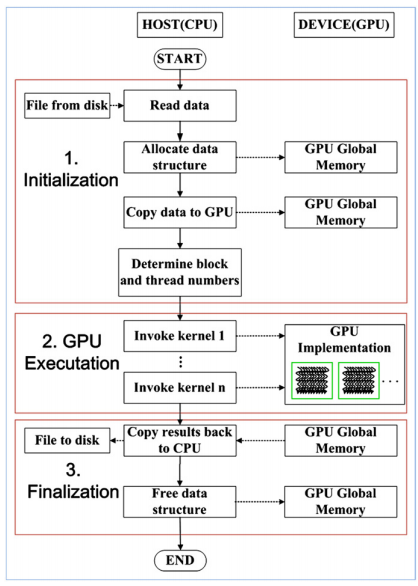多流向算法GPU并行化
和导师在Computers & Geosciences上发表的关于多流向算法GPU并行化的文章(SCI, IF=1.834)。
论文:http://sourcedb.igsnrr.cas.cn/zw/lw/201207/P020120717506311161951.pdf



As one of the important tasks in digital terrain analysis, the calculation of flow accumulations from gridded digital elevation models (DEMs) usually involves two steps in a real application: (1) using an iterative DEM preprocessing algorithm to remove the depressions and flat areas commonly contained in real DEMs, and (2) using a recursive flow-direction algorithm to calculate the flow accumulation for every cell in the DEM. Because both algorithms are computationally intensive, quick calculation of the flow accumulations from a DEM (especially for a large area) presents a practical challenge to personal computer (PC) users. In recent years, rapid increases in hardware capacity of the graphics processing units (GPUs) provided in modern PCs have made it possible to meet this challenge in a PC environment. Parallel computing on GPUs using a compute-unified-device-architecture (CUDA) programming model has been explored to speed up the execution of the single-flow-direction algorithm (SFD). However, the parallel implementation on a GPU of the multiple-flow-direction (MFD) algorithm, which generally performs better than the SFD algorithm, has not been reported. Moreover, GPU-based parallelization of the DEM preprocessing step in the flow-accumulation calculations has not been addressed. This paper proposes a parallel approach to calculate flow accumulations (including both iterative DEM preproces- sing and a recursive MFD algorithm) on a CUDA-compatible GPU. For the parallelization of an MFD algorithm (MFD-md), two different parallelization strategies using a GPU are explored. The first parallelization strategy, which has been used in the existing parallel SFD algorithm on GPU, has the problem of computing redundancy. Therefore, we designed a parallelization strategy based on graph theory. The application results show that the proposed parallel approach to calculate flow accumula- tions on a GPU performs much faster than either sequential algorithms or other parallel GPU-based algorithms based on existing parallelization strategies.


